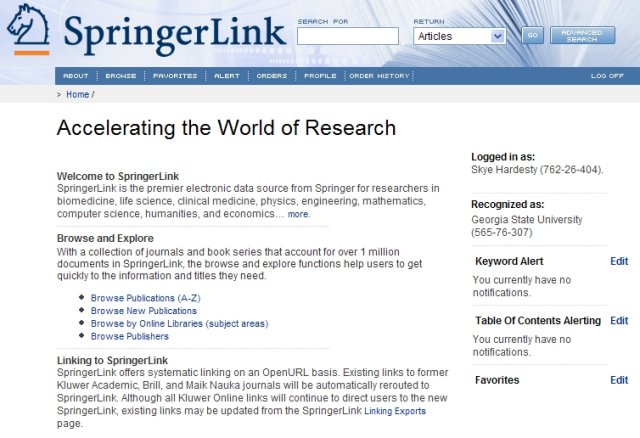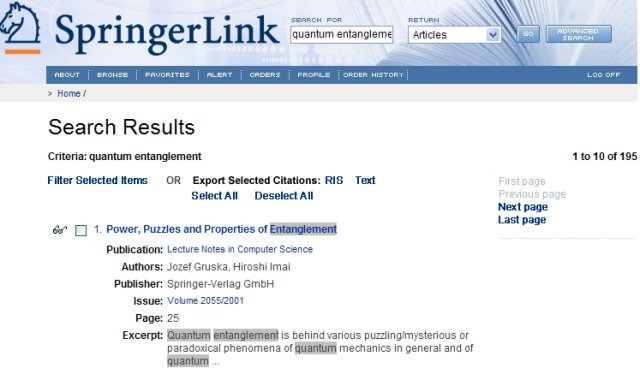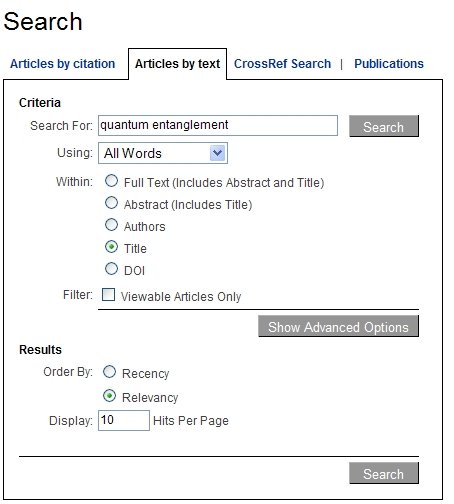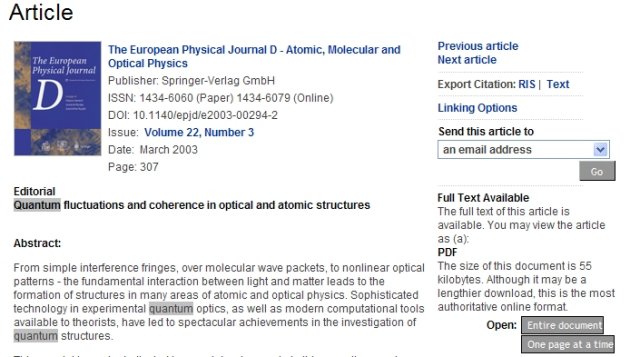Database Reviews
SpringerLink
Science Liaison
Georgia State University
Atlanta, Georgia
skye@gsu.edu
SpringerLink is an online collection of over 1,200 peer-reviewed journals and 25 book series published by Springer covering a variety of topics in the sciences, social sciences, and humanities. SpringerLink contains citation and abstract information back to volume 1, issue 1 for most titles (Springer is in the process of digitally converting the back issues of all its titles). In most cases, full-text access, based on individual or institutional subscriptions, is available back to 1996 for each "current" journal title subscription. For earlier coverage, subscribers must purchase the historical archive (1843-1996) at additional cost. SpringerLink is also the gateway for accessing the products Landolt-Börnstein, Springer eBooks collection, and Springer reference works.
Browsing and Searching
Users can either browse the journal and book series collections, or search by keyword in both basic and advanced searches. The browse options presented on the SpringerLink home page are publications (A-Z), new publications, online libraries (subject areas), and publishers (see Figure 1).

Figure 1
SpringerLink doesn't define "new publication" and those items also appear in the A-Z list. An eyeglasses icon indicates which titles users have access to based on their institution's subscriptions. There are 13 subject libraries, collections of journal titles with links to their content by issue, covering such topics as behavioral science, biomedical and life sciences, computer science, engineering, and mathematics as well as the Chinese Library of Science and Russian Library of Science. A separate "Browse" tab at the top of the SpringerLink home page allows users to limit the length (default is 50) of their browsing lists or limit their browse to viewable publications and/or new publications. Though the SpringerLink home page does not offer a browse list of book series, the "Browse" tab does. The tab also offers a redundant link to the subject libraries.
SpringerLink offers two content searches by keyword; there is no full-text searching capability. The "basic" option is a search box that is located in the upper right of all SpringerLink pages (see Figure 1). The box has "Search for" above it and to the right of it is a "Return" box with a drop down menu offering "Articles,""Publications," and "Publishers." A search for articles on 'quantum entanglement' returned 195 articles and books, with the search terms highlighted and the eyeglasses icon indicating accessible content (see Figure 2).

Figure 2
The "basic" searching searches for terms in the entire bibliographic record and lists them in what seems to be relevance order, with search terms highlighted. Checkboxes allow users to select articles from their search results, and the "Filter Selected Items" creates a list of the selected records. In addition users can export their selected citation in either RIS format (for citation management software such as EndNote) or text. In order to e-mail an article or citation, users need to go into the individual records themselves where there is an "e-mail article" option.
The advanced search option, located next to the "basic" search box, allows four other searches (see Figure 3)

Figure 3
An "articles by citation" search requires part of a journal title, the exact journal title, or ISSN but additional information from the citation is optional. The "articles by text" search guides the user in constructing an "all words,""any words,""exact phrase," or "Boolean search" within full text, abstracts, authors, or DOI (Digital Object Identifier). Users can limit their searches to "viewable publications" and set the order or results by relevance or most recent, as well as number of hits per page. The "CrossRef search" allows users to search other participating publishers' content. The "publications search" allows users to search within the names and descriptions of Springer titles, and includes the filter for "viewable" publications.
Each individual record provides the user with the title of the article or book, author names and affiliations, bibliographic information about the journal or book, an abstract of the article, book, or book chapter, and options for e-mailing the article or book chapter, and viewing the full text of the article in PDF format. To navigate through the individual records in the search results users need to select "next article/chapter" or "previous article/chapter" (see Figure 4).

Figure 4
Personalizing
By creating an individual account, users can set up table of contents alerts, keyword alerts (saved searches), and select publications as "favorites." Creating an individual account does not limit users' access to content, since their institutional subscriptions are still recognized even when users are logged in as individuals. On the SpringerLink home page a user who has set up an individual account will see their keyword and table of contents alerts listed as well as links to their favorite titles. Users can change the alerts and favorites easily and at any time by clicking on the "Alert" and "Favorite" tabs at the top of any page in SpringerLINK
Conclusion
Publisher-specific databases like SpringerLink, Science Direct, and Wiley InterScience can confuse users who assume they are general science databases rather than resources that only reflect one publisher or publishing group. For this reason, I try to steer students and faculty away from these products as primary resources. Furthermore, if your university or organization uses OpenURL software, such as SFX, in your subject databases there isn't a pressing need to teach your patrons how to use SpringerLink in addition to, for example, Web of Science. Publisher-specific databases are useful for some users, though. Many faculty and graduate students think of the journals they access by publisher, and those who rely heavily on Springer titles will find the personalization functions in SpringerLink helpful. As a publisher-specific database SpringerLink is relatively clear and easy to use, additional features such as RSS feeds for new content and a way to e-mail citations from the search result list rather than only at the individual record level would be welcome improvements.
| Previous | Contents | Next |
